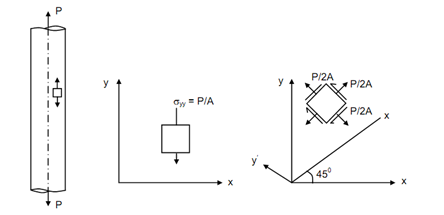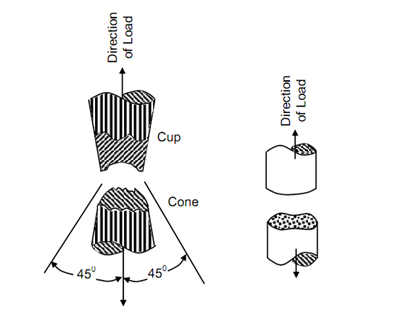Fracture in Tension
The tension specimens of ductile are brittle materials show distinctly different fractures. A brittle material in general fails due to tensile stresses, or in other words a brittle materials is weak against tensile stress. Consequently, a brittle material will fail along a cross-section on which maximum tensile stress is acting. The state of stress at any point with respect to x-y axes, where y-axis is along the axis of the tension specimen is shown in Figure. Over any cross-section of the specimen the tensile stress is uniformly distributed. Therefore, a brittle material is expected to fail along the cross-section. This is what actually happens. A cast iron specimen fails in tension along the cross-section, normal to axis. The surfaces of the fracture have granular appearances. Same will be true for any other brittle material.

Figure: (a) A Tension Specimen; (b) State of Stress at any Pont with respect to x-y axes when y- axis is Parallel to Axis of the Specimen; and (c) State of Stress with respect to x′ y′ axes when an angle45o with Axis of Specimen, the Maximum Shearing Stress equal to P/2A Acts Parallel to x′ and y′ Axes at any Point
On the other hand a ductile material is stronger against tension than against shearing stresses. In a tension specimen, the maximum shearing stress acts upon a plane that is inclined at an angle 45o with the axis as shown in Figure. However, due to formation of neck the state of stress changes considerably. Still the final fracture of a ductile material shows a characteristics cup-and-cone fracture surface. The cup and cone match at an angle 45o with the axis, showing that the final fracture has occurred along these planes all around the periphery. If a highly polished specimen is tested in tension then on the surface at yield point fine lines will appear. These lines are generally inclined beginning of sliding of atomic planes under the effect of maximum shearing stress

Figure: (a) Cup and Cone Fracture of a Ductile Material in Tension; and (b) Flat Fracture Surface with Granular Appearances in Case of Brittle Material